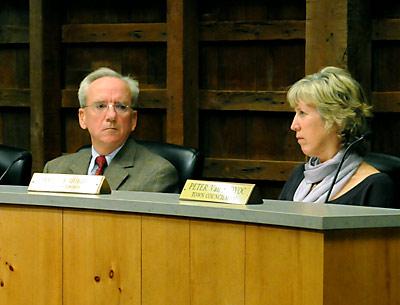Residents Push Back At Town Board
Residents Push Back At Town Board

Community members expressed dismay at an East Hampton Town Board work session Tuesday over the board’s recent bickering, and questioned Supervisor Bill Wilkinson’s stance on a proposed departmental reorganization as well as his attitude toward controversial clubs and restaurants in Montauk, his hometown.
The board, with three Republicans and two Democrats, has splintered on numerous issues during recent discussions.
“I cannot believe the childish behavior of all five of you,” Mary Ella Moeller said during a public comment period at the start of the meeting. “You behave with disrespect toward each other and your constituents, as well as the people in the audience.”
“You were elected, and you need to represent all the people in the town in the best possible way,” she scolded. “Forget about petty childish differences and work together, instead of being known as a dysfunctional board.”
“The public doesn’t deserve this,” Ms. Moeller continued. “We deserve a board that works for the town and does the town business in a respectful way, regardless of the party you belong to.” Some observers applauded.
“The Town of East Hampton is now under siege — a virtual Dodge City,” Larry Smith of Montauk told the board during his turn at the podium. “We are under — and particularly in Montauk — a clear and present danger to our environment and quality of life. We do not have adequate code enforcement officers to monitor our laws.”
“I see the town changing dramatically,” said Mark Levy, who said he’s lived in Montauk for 20 years. “In some ways it’s very nice. In some ways it’s like the Jersey Shore.”
In discussing the proposed reorganization of the Natural Resources and Planning Departments, said Mr. Levy, Mr. Wilkinson had said he wanted to free town planners to focus long range on advancing business development in East Hampton, as well as other goals. “It strikes me that your vision of Montauk is a very different vision,” he told the supervisor, reflecting, he said, “your support of the aggressive business community.”
“What I hear,” Mr. Levy said, “is ‘ka-ching, ka-ching, ka-ching.’ One dollar, one vote.”
Mr. Wilkinson’s viewpoint, he said, “should be part of the reorganization discussion. Then people will understand, really, what you’re trying to accomplish.”
Mr. Wilkinson remarked that he has lived in Montauk three times longer than Mr. Levy. “So I’d like to not say, ‘Everything old is new again,’ but, ‘Montauk has a long history.’ ”
He repeated details about clubs such as the Surf Lodge that he has often cited to underscore the longevity of such places in Montauk. “My sister played the organ at Ruschmeyer’s,” the supervisor said of a previous incarnation of another night spot that has disturbed its neighbors.
“I don’t see why the negative examples then should be used to defend the negative examples now,” Mr. Levy replied. “I’m not anti-business, I’m for good citizens.”
“What we have done is, we have brought the issues of the business community to the forefront,” Mr. Wilkinson said, adding that he has organized two symposiums to address business owners’ issues. “We have 6 percent of land devoted to commercial use” town-wide, he said. “We have done no major development, in spite of the hype you may have heard, in spite of the hyperbole you may have heard. We have encouraged businesses . . . places like the Ronjo.” That motel, now called the Montauk Beach House, has been a flashpoint of controversy on several scores. But such projects, Mr. Wilkinson said, employ residents and attract clientele who spend money locally.
“What I see is outside investors coming in,” said Mr. Levy, “not people who will build up Montauk as a community. One of the responsibilities of government is to distinguish between the fly-by-night people who want to make a buck and get out” and others, he said. “The changes that are being proposed are enabling of the bad citizens.”
Mr. Wilkinson countered by naming the owners of various Montauk bars and restaurants, pointing out their local residences. “So I don’t understand what you are talking about,” he told Mr. Levy.
The exchange prompted Councilwoman Theresa Quigley to speak out. “I was born and raised here. I am 57 years old. So I have you beat — not that it’s relevant,” she told Mr. Levy. “I’ve seen the changes more than you’ve seen the changes. I am 100 percent for the business owners, but that does not mean I’m not for the residents. But in my mind, the business owners are the residents.”
“We don’t have the proper zoning in this town. We don’t have the proper planning,” she continued heatedly.
People have commented, said Ms. Quigley, that the efforts of the town Planning Department over the years helped to preserve East Hampton. “Yeah, they did, but they forgot about the people who want to make a living,” she said. “Of course I don’t want to destroy the town, but I want to make a living. So yes, I’m pro-business, but I’m not pro destroying the town.”
Mr. Levy said Montauk had reached a “tipping point,” with “so many places, and growing so fast. I think that’s what’s changing the town.”
Another speaker returned to Ms. Moeller’s theme. “I’m a Johnny-come-lately,” Joan Lesser said, “so I don’t want to be condemned. What I don’t understand is the adversarial position that is taken — the preconceived notion that when somebody gives you a new idea, that it’s a bad idea.”
“What I hear is that no matter what people say, it’s a bad idea, and you’re not going to listen. As a taxpayer, that’s very disturbing,” she said. “Why are you so close-minded about these issues?”
Other speakers urged the board to allow the public to weigh in at a hearing on the changes proposed to the Natural Resources and Planning Departments. The proposal, backed by Mr. Wilkinson and Ms. Quigley, would shift responsibility for environmental reviews from planning to natural resources, moving several staffers from one department to the other. It would also create a new “natural resource reviews group” and “environmental protection unit,” placing them, as well as the Aquaculture Department and the community preservation fund office, under Natural Resources Department authority.
A resolution authorizing the change has failed to gain support among other board members, who have called for a more detailed explanation of the new entities and a review of whether town code changes would be required.
Jeanne Frankl, who heads the town Democratic committee, told the board a hearing would be “an opportunity . . . to dispel the suspicions that it’s just another slap in the face of [the planning director] Marguerite Wolffsohn, and another attempt to undo the planning board’s rigorous review of natural resources” issues.
Mr. Wilkinson responded that “it’s ironic” that a move by the 2008 town board, all of them Democrats, to shift personnel from Natural Resources to the Planning Department was done without a hearing. “So I don’t understand the great cry for public attention at this point,” he said.
He said he had vetted the reorganization with John Jilnicki, the town attorney. “Absent of that, I am not going to introduce non-legal competencies to the legal field,” he said.
Mr. Wilkinson has said the intention is to free the Planning Department to pursue long-range planning initiatives, and Ms. Quigley said Tuesday that it is simply to repopulate the Natural Resources Department, moving staffers whose present jobs logically fall under that umbrella, without changing any duties or job descriptions.
But, said Councilwoman Sylvia Overby, the proposed resolution states that “as a result of this reorganization, the Planning Department will no longer be responsible for natural resource reviews,” a substantive change.
“I will just repeat what I said before,” Mr. Wilkinson said, reciting again how staff was shifted in 2008. “So when they move there, it’s fine, but when they move back, it’s not fine, you have to have a public hearing?”
“So what?” Ms. Lesser asked. “Just because someone did it wrong doesn’t mean you have to do it again.”
“It’s the public that is interested,” Larry Smith said. “I just don’t understand why anybody would want to preclude public interest, and public participation in the public process.”
When Rona Klopman, a Democrat who was in the audience, spoke out, interrupting Ms. Quigley to ask that she let Councilman Peter Van Scoyoc speak, Mr. Wilkinson threatened to move the meeting to a smaller room — the type of space, he said, where the previous, Democratic, administration had held its work sessions before a larger meeting room was provided in the new Town Hall.
“And this entire audience will be left out,” he said.




